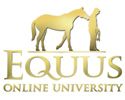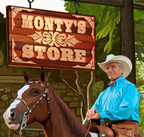I have been working with horses for almost 30 years now and over the last 10 years have been completely obsorbed by Montys technique and approach to gaining trust with Equus.I find the whole language so interesting to watch,when done correctly and non aggressively,which i have seen so many times by others,Monty proved it does not have to be that way.
Since i started in the practise of horse handleing i have come across many horses with differant behaviour problems from Green horses and ponies accepting their first Headcollar to horses that will show dominance towards the handler as soon as he or she approaches them and i am still unsure how to deal with such situations.
My question is this,How can i fit a head collar to a horse or pony in a paddock, that persists in lunging towards me with its ears back and tries to kick too, as soon as i approach?
My second question is,How do i fit a head collar to a foal or yearling, that is completely wild that has had very little or no human contact,without causing to much stress to the animal?




#1 when approaching, get their attention; you must have their FOCUS.
#2 BE SAFE--when first starting out with horses, I always carry something that the horses will notice that will keep me safe; [watch Monty`s videos and you will notice that he always carries something with him while working the horses]; you can use those objects to chase the horse away if they become too preditorial. Remember, when working horses, the energy that comes with moving the feet is huge in the eye of the horse. They are trained from the birth about whomever moves the feet first, is the leader and thus, to be followed.
#3 Keep the lesson short and sweet when starting out [incremental steps] As soon as the horse steps away, release the pressure of your presence by turning away also.
#4 Advance and retreat with this approach with ultimately being able to scratch him between the eyes and then leave.
#5 If you look at this whole procedure as dance, the horse will learn faster, and become a partner. Remember, you are trying to build a relationship through movement. Horses tend to keep their adrenalin down and under control when they are allowed to move.
#6 You are working with the unseen [ energy] with this approach and the horses are ZEN MASTERS at this; so do your homework and have a plan before you start.
The same approach can be done with a foal, but it is MUCH EASIER to accomplish if separated from other horses. I have raised 30 babies in my life and learned early on that the use of a hoop [ piece of hose looped into 30 inch hoop and duct taped together is much easier to use than a halter for the first few captures [join-ups]. They know nothing of pressure and release at this point, so this is the time to bring that into their world. However, establish the TRUST between you two first. Take it slow and VERY EASY with the foal. You represent the very first contact that this baby will have with a human so make sure that your touch is one of GENTLELNESS.
Best of luck and please keep us in the loop with your progress
Bud
Monty`s entire approach to join-up is based on this principle.
Sorry about this,
Bud
So far the work with the foal has come on quite quickly,due to its age and curiosity,when i have her in the Coral now,she starts to show attention to me and then walks up to me,i have my eyes looking away,when this happens,i can now place a head coller on her and she will walk round the coral with me,it really is a thrill for this to happen,all actions are done calmly and quietly and when i have finished after around 10 to 15 minutes,i remove the headcoller and i walk away from her,not her walk away from me,i have applied this to all the ponies and horses as and when they have had some training,i believe this reinforces the trust that has already been gained.
As for the aggressive Thoroughbred,that will take longer,he has a very dominant attitude and will cause harm given the chance,he even tries to bite and kick when i am standing outside the paddock by the fence,so i will start using a long stick to scratch his withers from a safe distance.I will update on here with progress on that one.
I have recently be helping an elder woman with her Caspian breed ponies,these seem to have lost manners,my approach was get the horse to trust me before i do anything else,this advice given from other forum users,and after about 2 weeks of just being a round the pony and not putting a Headcollar on him,yesterday he had the Headcollar put on for the first time in a long while,which was Montys Dually Halter,i used it as a leading collar to lead with and then a training collar when he started to walk through me,and i put him back,and it worked with great results,i have now changed to a normal Headcollar for leading withand one of the stable girls is now leading him under my supervision and a bit of advice now and again and it is working well,lets hope they keep it up.One issue that really annoys me is people who wrap lead ropes around a horses nose to make them respond to pressure,but without the release! the Dually does this naturally,i do not understand why some handlers will not use Duallys,it takes longer to wrap a rope round a horses nose for one,and secondly there is no release from the pressure,how can a horse understand what is require with constant pressure which would induce stress and panic to the horse resulting in negative actions,from horse and handler.USE A DUALLY.